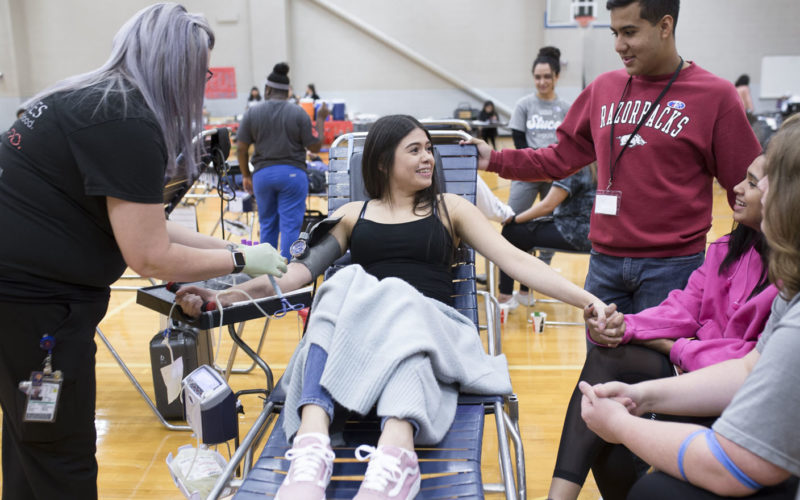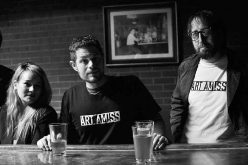LARA JO HIGHTOWER
lhightower@nwadg.com
Many of us look for ways to give back during the holidays as a chance to demonstrate gratitude for what we have by helping others who might not be so fortunate. Northwest Arkansas is chock full of wonderful nonprofit organizations that can always use a helping hand, but if you’re looking for a way to kick your giving up a notch, consider these three organizations for a chance to — literally — give a piece of yourself to save someone else’s life.
Community Blood Center of the Ozarks
3503 S. Thompson, Springdale, (479) 927-1200
1400 SE Walton Blvd., Bentonville, (479) 464-2506
“There are 12 hospitals in Northwest Arkansas that use blood that comes from our center and nowhere else,” says Community Blood Center of the Ozarks Marketing Manager Chris Pilgrim. “And over 40 hospitals from southwest Missouri and Northwest Arkansas, combined.”
Donating blood is one of the easiest ways to save someone’s life, says Pilgrim, but only a small percentage of the population actively participates. Out of the 37% of Americans who are eligible, only 10% actually give.
“You would think that a fear of needles would be the No. 1 reason people don’t give blood — and while that’s pretty significant, it’s not the biggest reason,” he says. “The biggest is just that people have never been asked. It’s kind of something that goes on in the background. It takes a conscious decision for 200 people a day to donate blood and keep things going here.”
If aversion to needles is your issue, fear not, says Pilgrim.
“If you’re scared of needles, it doesn’t hurt very much — it’s a slight sting, and the needle is in your arm for maybe 10 minutes,” he says. “When you’re finished with your donation, you walk out. It’s that easy. It doesn’t take much time or any money, but it has a real impact on someone’s life. That’s the biggest gift you can give, when you save lives.”
And each donation, says Pilgrim, saves multiple lives.
“We used to say that one donation could save three lives, because we divided it up into red blood cells, platelets and plasma, but your blood donation could get divided up and go with lots of people — the more you give, the more you multiply.”
While all blood donations are valued in order to keep the area hospitals fully stocked, Pilgrim says that some blood types are a lot more in demand than others.
“There are a couple of specific blood products that we look for,” says Pilgrim. “First of all, when you’re talking about red blood cells, O Negative is a universal type. Even though only 6% of the population is Type O Negative, it’s used more than its fair share in trauma cases when you can’t readily type a victim. The other universal is AB plasma — it can be given to anybody.”
You can give blood at any of the center’s locations — there are also two Missouri locations — and it’s suggested that you first make an appointment online to expedite your visit. Pilgrim says the bulk of the donations, however, are collected at blood drives.
“The vast majority of the blood we collect comes from places where we take our show on the road — churches, schools, businesses,” he explains. “If you have a business that wants to hold a blood drive, please give us a call. We can take you through the steps and help make it as painless and rewarding as possible.”
Project Zero
theprojectzero.org
Tiphanie Gurwell, Northwest Arkansas outreach coordinator for the nonprofit organization Project Zero, says there are hundreds of children in Arkansas who are waiting to be adopted — and it’s her organization’s goal to find each and every one of those children a home. Project Zero, according to its mission statement, will “diligently and enthusiastically promote adoption through the foster care system with the ultimate goal of finding a forever family for every child that is waiting.”
Project Zero works specifically with a group of children who might be harder to place, says Gurwell.
“A lot of these kids are part of a sibling group, or they have special needs, or they’re teenagers,” she says. “So they’re what we would consider the harder-to-place kids. When most people go into adoption, they want younger kids; that number doesn’t take into consideration the kids that are having their parental rights terminated but are getting adopted quickly. We generally don’t advocate for a child under the age of 5 unless they’re in a sibling group or have a special need.”
Gurwell says one of the ways the organization seeks to connect potential adoptive parents with children are its private events where children and adults mix and mingle and get to know each other, like the one coming up in Little Rock.
“Seventy-nine percent of the kids [in state care] will attend this event,” says Gurwell. “They’ll come and get Christmas presents and play fun games, all while interacting with families who are looking to adopt. They may connect in a way they don’t just by looking at a photo on the internet. It’s kind of a game changer, because you get that one opportunity, and it’s no longer just a picture or a number — you get to meet with and talk to the child.”
Even one visit to the organization’s website is enough to personalize its mission: It maintains a “Heart Gallery,” a collection of pictures, biographies and, sometimes, videos of the children for whom they’re advocating. The photos show smiling, hopeful faces, and the biographies are heartbreakingly forthright about the trauma the child might have endured and the special needs that resulted. But they also give insight into each child’s particular personality and their hopes and dreams for their futures.
“I really didn’t have a family in my past, and I would like to start over and build a new life in a new family that loves me, and I love them, and that cares about me and loves me and understands what I’ve been going through,” says Andreka, a teenager, in a short video. Though the teenagers in the Heart Gallery may be aging out of the system soon, their need for a permanent placement is still great, says Gurwell.
“Typically, the kids that age out of foster care don’t end up doing the best,” explains Gurwell. “If you grew up your whole life, and no one ever taught you how to budget, how to pay a bill, how to apply for a loan, how to apply for college — what ends up happening is that, at the age of 18 or 21, they age out with very little knowledge. [The Division of Children and Family Services] does the best they can do, given their resources, but when you get out in the real world, and you’re working a minimum wage job, you’re trying to go to college and there’s no one to ask for help? The statistics show they’re likely to end up in the same situation that they were removed from. A lot of them will end up in jail or homeless.
“I think it’s important for people to get these kind of negative stereotypes out of their head — like, they’re going to come into my house angry, or they don’t want to be adopted. There are a million different excuses people have when talking about teens, but I’ve had the opportunity to meet a lot of our teens, and they do want to be adopted. They want to be loved. Even if it’s a short period — let’s say you adopt at 16 or 17 years old. Those two years can be a game changer. They’ve got someone to come home to. It may be a minimum time in your home, but it’s a lifetime commitment to that child.”
Gurwell says there’s no one profile of a family that would make good adoptive parents.
“Every child has a different story,” she says. “Some kids need a single mother because of their trauma. Some kids need a two-parent family or need to be the only child or youngest child in the home. Each case is so unique. I would say the only thing we wish for in our families is, obviously, that they be able to support the child financially without government assistance. From our organization’s perspective, we want families who are open-minded, we want families who aren’t going to come in and say, ‘I want a kid 5 and under.’ We want families who say, ‘We are called to do this, but we don’t know what it looks like, so let’s just roll with it and see what happens.’ I think sometimes when we put barriers up of what we don’t want, it limits the connections you might make with someone you might not even think about looking at — but then you meet a child, and it’s a game changer.”
For those interested in exploring the possibilities of adoption, the Project Zero website is a great place to start and can explain what the next steps in the process would be.
Be the Match
Bethematch.org
(800) MARROW-2
When Bill Brashear got the news that his son was diagnosed with acute lymphoblastic leukemia, it was a shock: His son was a healthy young man in the prime of his life who had never experienced previous health issues.
“It was gut wrenching,” he says. “It was horrible. But the wonderful thing that came out of it was [our knowledge of] Be the Match.”
Early on in his treatment, Brashear’s son needed a blood stem cell transplant; fortunately, a match was found within his family. But when he needed another one later on, the family turned to the international donor database Be the Match.
“They did a search for [my son’s] DNA makeup and didn’t find a match in anyone in the United States but found a young man in Germany,” says Brashear. “They harvested this person’s blood cells in Germany, a courier was there, got the blood cells that he had donated, flew back to the United States, and the next day, they were infused in [my son].”
Clifford Ackerman now works with the organization as a patient and lead liaison, but his first introduction to Be the Match was as a patient when he was diagnosed with non-Hodgkin’s lymphoma.
“I had two sisters and a fraternal twin, and nobody matched me,” he says. “I found a match through Be the Match, and now I have a blood brother who saved my life by joining the registry eight years before to help someone in his community. We just celebrated Thanksgiving — if you want to show how thankful you are for what you have, this is a wonderful way.”
Be the Match collects donations in three areas: peripheral blood stem cells (PBSC), marrow and umbilical cord blood. These donations can be used to help treat 70 different blood diseases and cancers. Be the Match facilitated nearly 6,200 transplants in 2018. But with nearly 70 percent of patients requiring transplants outside their friends and family group, new donors are always needed.
“It’s very similar to donating plasma platelets,” Ackerman explains of the outpatient process, which is open to donors ages 18 to 44. “Nothing is completely painless — there’s always a small discomfort to save a life. With this process, it’s either a bit of achiness before or after the process. It’s not like what you see on Grey’s Anatomy or ER or House — you don’t feel pain or discomfort during, but maybe some achiness afterward.”
Most matches are found by people who match the patient’s ethnic background, and the likelihood of a patient finding a match in the system ranges from 77% for white patients, 57% for American Indian and Alaska Native patients, 46% for Hispanic or Latino patients, 41% for Asian or Pacific Islander patients and 23% for African-American patients.
The entire process, from the initial medical exam to determine eligibility through the donation procedure, usually takes around 30 hours, says Ackerman, and is entirely free for the donor — it’s either paid for by the patient’s insurance or by Be the Match.
“We pay for the travel, the meals and even for one companion,” says Ackerman. “Even tolls, mileage, day care — even pet care. If they come up to us and say, ‘Hey, I started a new job or ran out of paid time off’, we’ll even cover their wages.”
Ackerman says a young man named Bélee, a 2014 graduate from Pulaski Academy in Little Rock, is currently looking for a matching donor to help treat his aplastic anemia. To start the process to see if you’re a match for Belee — or another patient currently waiting on a donor — scan the QR code pictured with this story or text NWADG4aCure to 61474. Ackerman says the initial screening is simple and fast, and a swab kit can be mailed to your home address quickly.
“Be the Match is such a big deal,” says Brashear. “It saved [my son’s] life, and it’s saved other people’s lives, but we don’t hear enough about it. That’s why I’m shouting from the rooftops and ringing the bells and whatever else to get the word out — because it might save somebody’s life, for sure.”






